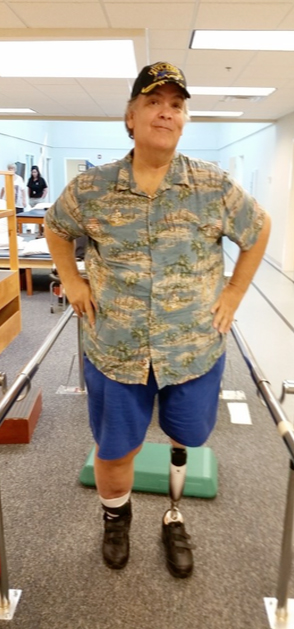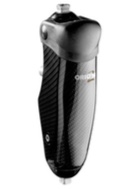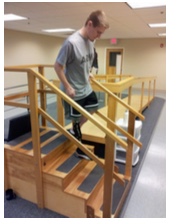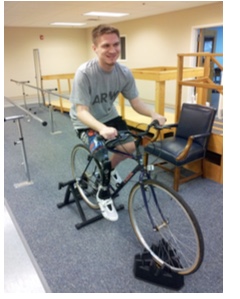US Veteran Michael’s Story
Trevor’s Motorcycle
Kim’s Story
Mark and his custom UK Socket
Look Who’s Moving!
 Rodney Jones first came to Abilities In Motion in the summer of 2013. A truck driver for several years, Rodney was injured while on the job. After several failed attempts to reset his leg for healing, the decision was made to amputate Rodney’s left leg.
Rodney Jones first came to Abilities In Motion in the summer of 2013. A truck driver for several years, Rodney was injured while on the job. After several failed attempts to reset his leg for healing, the decision was made to amputate Rodney’s left leg.
Rodney worked incredibly hard over the past 1.5 years to get to this place in his life. When Rodney started coming to AIM, Rodney also started working with Premier Physical Therapy (AIM’s inhouse PT). By coming in multiple times each week, Rodney has progressed from using a wheelchair, to parallel bars, to a walker, to a cane and finally has reached unassisted walking. The AIM and Premier teams are extremely proud of Rodney’s progress.
Rodney’s work-related injury forced him to live a very sedentary lifestyle before his amputation.
Though it took a good attitude and a lot of effort, Rodney is now 196 pounds lighter and living the life that he wants to live.
Recently, Rodney started driving by himself again. He has loved being able to regain the independence that he has lacked for so long. Along with AIM’s prosthetic care services and Premier’s physical therapy services, Rodney’s positive attitude has helped him come this far. To him, the amputation was just a “little speed bump” and he finds it important to have fun even in the midst of challenging times. Whether he is driving himself to the hardware store or riding his bike around the neighborhood, it is evident that Rodney is moving forward.
Rodney’s Hardware
 As a part of the rehabilitation process, Rodney initially used a prosthesis with a locking knee for 12 months. He then transitioned into using the technologically advanced Orion2 knee from Endolite.
As a part of the rehabilitation process, Rodney initially used a prosthesis with a locking knee for 12 months. He then transitioned into using the technologically advanced Orion2 knee from Endolite.
This microprocessor controlled knee unit uses Motion Integrated Intelligence (Mi2), which allows Rodney to feel more secure ashe stands, rides his bike, and walks. This knee can lock at various angles and features progressive speed control. Also,the sensors within the knee allow for Rodney to walk up ramps and hills with more security.
These components have allowed Rodney to progress from initially using a walker to now walking unassisted at variable walking speeds and negotiating ramps and stairs.
Get Moving!
Bob Haggard serves as an active reserve in the US Army. As a typi- cal 23 year old, he enjoys many high energy, outdoor activities such as cycling and running.
 In January of 2012, Bob was involved in an automobile acci- dent. Due to his accident Bob had his right knee fused in slight flexion.
In January of 2012, Bob was involved in an automobile acci- dent. Due to his accident Bob had his right knee fused in slight flexion.
This caused difficulty sitting in tight spaces, such as bleachers at sporting events. He has had multiple surgeries to his elbows, as well as amputa- tions of fingers and thumb of his right hand. Bob continued to have pain in his left knee and limited range of motion in his left ankle.
In April of 2013, Bob decided to undergo an above knee amputation on his right leg. This was a big decision, but one that he felt was right for him. On June 6, 2013 we fitted Bob with his above the knee prosthesis.
Bob’s rehab has gone very well. He quickly learned to walk without assistance. With his youth, strength and agility working in his favor, he even taught himself to run.
 Bob’s next goal is to be able to cycle. As seen in the photo, he has converted his bike into a stationary unit. This allows him to learn how to
Bob’s next goal is to be able to cycle. As seen in the photo, he has converted his bike into a stationary unit. This allows him to learn how to
balance and pe- dal safely before hitting the trails.
His prosthetic knee has the option of turning off the stance resistance and functioning in a free swinging mode.
We can certainly say as far as Bob is concerned, he is definitely moving forward!
Joy’s Story
Abilities In Motion, Testimonial by Don
Gerald Evans

Gerald Evans is a basketball man. Simply put, he loves the sport. A keen player for many years, Gerald has been talking about it since we first met him.
Gerald has been playing basketball all his life, starting with playing on youth teams. He also played for Woodward High School and started as a center.
In his college years, Gerald continued to play ball. He started for two years as a forward for Cincinnati State University.
He went on to play many years of pick up games after he finished college. Gerald would often play several times a week.
When we began his rehabilitation from his amputation, basketball was always part of the conversation.
At first he would joke about getting his jump shot back. This was when he was getting measured for his first prosthesis.
After fitting him with his initial prosthesis which included a highly efficient energy storing foot, Gerald quickly transitioned to a cane, then walking without assistance in just a couple of months.
Gerald keeps himself in shape at home using a treadmill, which he uses daily.
More recently, he was fit with an elevated vacuum system, which provides greater control of the prosthesis. This system has really helped Gerald on the court. He has been working hard with the new prosthesis on perfecting his jump shot. He told us that the new system has really helped with the control needed to jog around the court and to jump in the air without having to worry about the landing.
So with the jump shot now perfected, there is just the matter of working on the slam dunk!
When we asked Gerald if this was a goal of his, he replied,
“It’s been many years since I last did that! Maybe it’s something to look forward to, but not today.”
Keep up the great work Gerald. Once you get that slam dunk down, you’ll be ready to play a little one on one against Tom!
Benefit Questions
Although most people know about Social Security retirement benefits, far fewer know that people with disabilities—those who can no longer work because of injury or illness—may also qualify for Social Security benefits, regardless of their age. The process of obtaining such benefits can be confusing and as a result there are many misunderstandings. Here are a couple of myths explained from the inMotion Magazine May Edition.
1. If I am disabled, it is easy to obtain disability benefits.
Actually it can be a difficult and frustrating procedure. Initially you must be interviewed either in person or via phone. The majority of applicants are turned down upon initial application. However chances of approval increase when you file an appeal, which can take differing forms in each state.
2. Disability benefits and Medicare benefits are unrelated.
Once you have received disability benefits for 24 months, you qualify for Medicare benefits, regardless of age. The rules for disability are complicated, and you should seek assistance to determine whether you are eligible for benefits and to assist you in applying for them.
